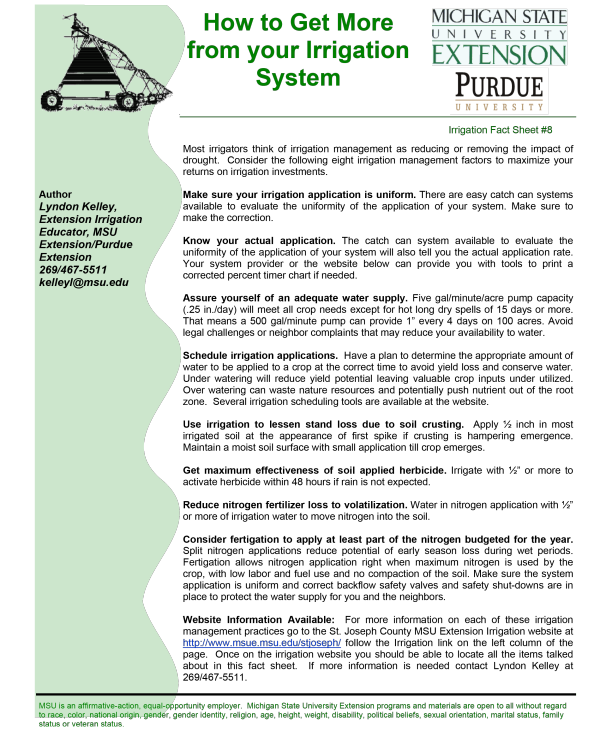
Bulletin Irrigation Fact Sheet #8
How to Get More from your Irrigation System
DOWNLOAD
February 1, 2010 - Lyndon Kelley, Michigan State University Extension
Most irrigators think of irrigation management as reducing or removing the impact of drought. Consider the following eight irrigation management factors to maximize your returns on irrigation investments.
Make sure your irrigation application is uniform. There are easy catch can systems available to evaluate the uniformity of the application of your system. Make sure to make the correction.
Know your actual application. The catch can system available to evaluate the uniformity of the application of your system will also tell you the actual application rate. Your system provider or the website below can provide you with tools to print a corrected percent timer chart if needed.
Assure yourself of an adequate water supply. Five gal/minute/acre pump capacity (.25 in./day) will meet all crop needs except for hot long dry spells of 15 days or more. That means a 500 gal/minute pump can provide 1” every 4 days on 100 acres. Avoid legal challenges or neighbor complaints that may reduce your availability to water.
Schedule irrigation applications. Have a plan to determine the appropriate amount of water to be applied to a crop at the correct time to avoid yield loss and conserve water. Under watering will reduce yield potential leaving valuable crop inputs under utilized. Over watering can waste nature resources and potentially push nutrient out of the root zone. Several irrigation scheduling tools are available at the website.
Use irrigation to lessen stand loss due to soil crusting. Apply ½ inch in most irrigated soil at the appearance of first spike if crusting is hampering emergence. Maintain a moist soil surface with small application till crop emerges.
Get maximum effectiveness of soil applied herbicide. Irrigate with ½” or more to activate herbicide within 48 hours if rain is not expected.
Reduce nitrogen fertilizer loss to volatilization. Water in nitrogen application with ½” or more of irrigation water to move nitrogen into the soil.
Consider fertigation to apply at least part of the nitrogen budgeted for the year. Split nitrogen applications reduce potential of early season loss during wet periods. Fertigation allows nitrogen application right when maximum nitrogen is used by the crop, with low labor and fuel use and no compaction of the soil. Make sure the system application is uniform and correct backflow safety valves and safety shut-downs are in place to protect the water supply for you and the neighbors.
Website Information Available: For more information on each of these irrigation management practices go to the St. Joseph County MSU Extension Irrigation website at http://www.msue.msu.edu/stjoseph/ follow the Irrigation link on the left column of the page. Once on the irrigation website you should be able to locate all the items talked about in this fact sheet. If more information is needed contact Lyndon Kelley at 269/467-5511.



 Print
Print Email
Email


